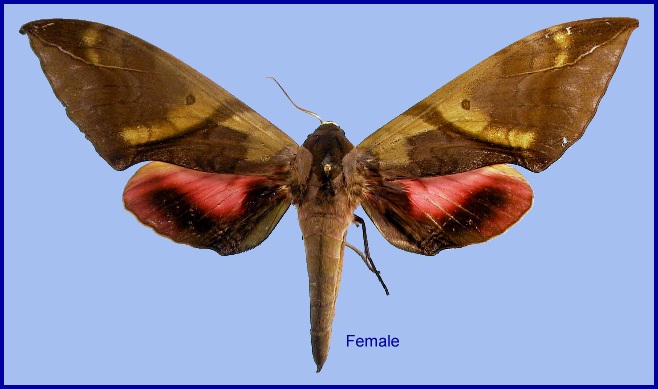
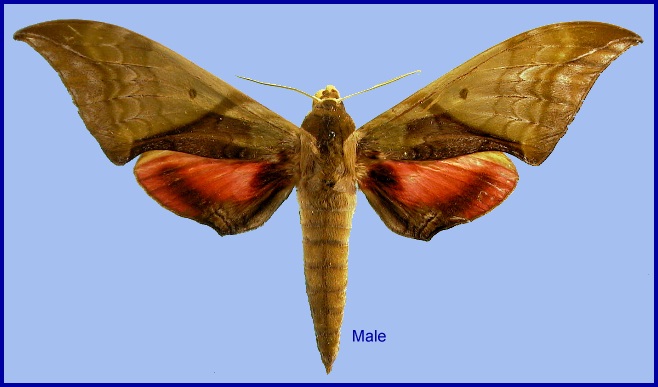
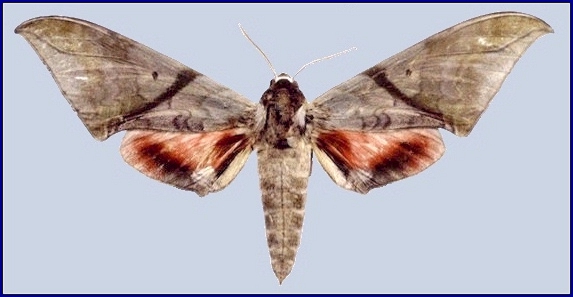
Ambulyx rubricosa Walker, 1856, List Specimens lepid. Insects Colln Br. Mus. 8: 122. Type locality: India.
Synonym. Ambulyx rubricosa Walker, 1856.
Synonym. Basiana superba Moore, 1866.
Synonym. Callambulyx rubricosa indochinensis Clark, 1936.
Wingspan: 132mm. Head and vertex of thorax olive-brown, antennae and a band between their bases white; sides of thorax purple; abdomen greenish, with a reddish-brown dorsal line. Forewing bright glaucous-green (in unfaded individuals), with olive-green markings and a patch of purplish-grey on inner margin; two indistinct waved antemedian lines; an oblique, nearly straight olive-brown band from middle of costa to outer angle; a spot at lower angle of cell; two humlate postmedian lines and one waved line; outer area olive with some white on it; an oblique apical line white bordered with blackish-brown; white spots on outer margin. Hindwing brilliant crimson, the base and a post-discal band extending to Cu2 darker red; traces of a median line; inner area brownish, marked with grey. Underside bright orange suffused with red, the lines of the forewing at least partly red; median line of hindwing curved (Bell & Scott, 1937).
In the male genitalia, uncus relatively weakly sclerotised, narrowing gradually towards apex; apex weakly emarginated; medial line raised as a carina; proximal part more strongly sclerotised and densely clothed with long hair-scales. Gnathos reduced, lacking a medial lobe. Valva narrow, tapering to rounded apex; harpe well developed, produced into a long and a short, curved pointed process. Phallus lacking armature. In the female genitalia, lamella postvaginalis crescent-shaped, broadly rounded terminally; lamella antevaginalis approximately triangular.
Callambulyx rubricosa is very similar to Callambulyx amanda, but hindwing upperside lacks a prominent black marking near the tornus.
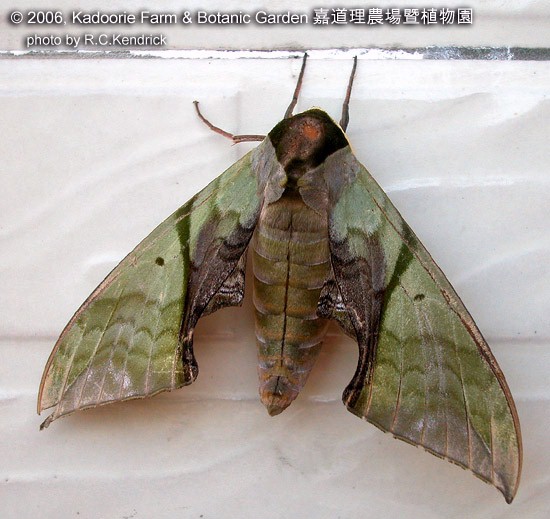
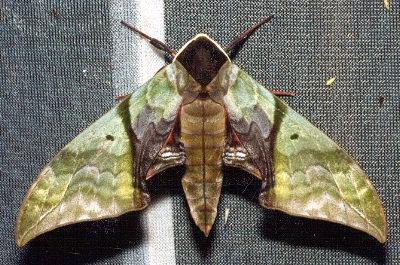
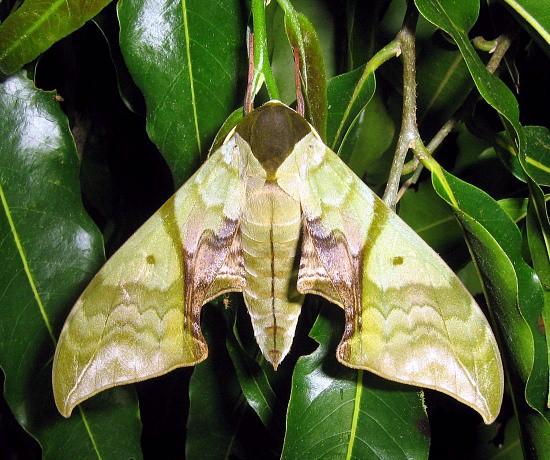
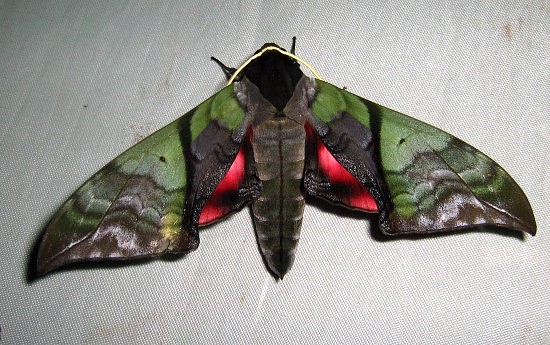
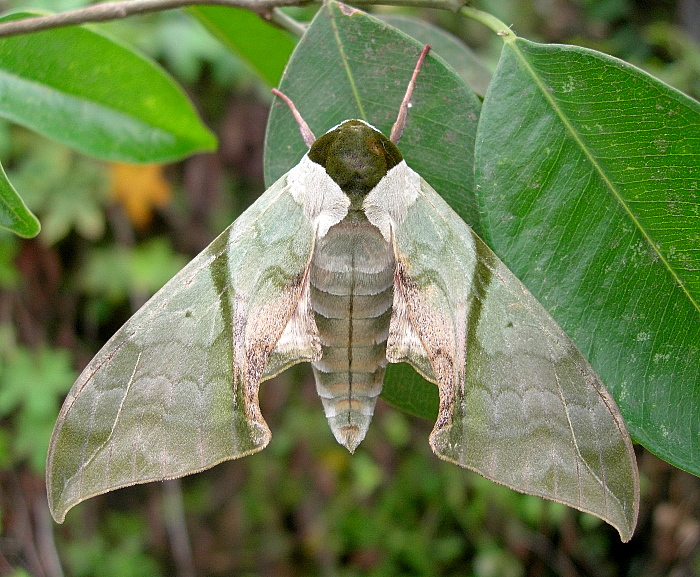
China: 22-25.iii (Hainan); 14.ix (Xishuangbanna).
OVUM: Oval, 1.40 x 2.10mm. Pale yellow when mature, with the larval horn showing through as a red line (after Eitschberger, U. & Hoa Binh Nguyen, 2012).
LARVA: Full-fed 70--100mm. Very like Callambulyx tatarinovii tatarinovii at every stage, with up to six instars.
Newly hatched larvae are pale yellow, without any markings. Horn long and dark, with some red/orange at base; tip bifurcate. Body cylindrical, of even thickness, rugose; head spherical. Body colour similar in the next instar, a little greener, with a narrow, pale dorsal line from horn to head; faint pale oblique lateral stripes may also start to appear, as well as cheek stripes. Legs of the same colour. Horn now red with darker tubercles, and still bifurcate; head conical with a apical thorn. Body still cylindrical, but more rugose. The third instar is very similar. The body becomes a little greener, and the red of the horn may extend along the pale dorsal line, and also appear on the head thorn and prolegs. In some, the red dorsal suffusion may also extend down along the oblique lateral stripes. In the fourth instar the basic body colour is more green than yellow, with numerous yellow tubercles. The thin dorsal line (now broader with larger, thorn-like tubercles) may become entirely red, with this same colour becoming more pronounced on every alternate oblique lateral stripe. These 'thicker' stripes often have white centres. All legs becoming more reddish. This colour scheme and patterning continues into the next (fifth) instar, with the white centres of the oblique lateral stripes becoming quite pronounced in some. In the final (usually sixth) instar the colours and patterns are the same, but more well defined. The red head thorn is lost. The true legs become more red, as do the anterior and posterior 'yellow' body tubercles, except for those on the anal flap and claspers, which may become greenish-blue in some. The dorsal line is now a small crest of red thorns. Fully grown, most are basically leaf green, but some are more yellow with a greater degree of red suffusion. All forms turn purple prior to pupation (after Eitschberger, U. & Hoa Binh Nguyen, 2012).
PUPA: 40--50mm. Dark mahogany brown and slightly glossy; tapering caudad from a blunt head and thorax. Proboscis not present, but replaced by a knob-like tubercle. Wings and abdominal segments finely striate, but glossy. Anterior edge of each abdominal segment heavily punctate, more so than in Marumba. Cremaster broadly conical, with a sharp point; tuberculate. Overall, similar to that of Smerinthus ocellata, but less glossy. Formed in an almost silk-free cell in the soil. The overwintering stage (after Eitschberger, U. & Hoa Binh Nguyen, 2012).
Larval hostplants. Has been reared in captivity on Salix caprea (Eitschberger, U. & Hoa Binh Nguyen, 2012), indicating that a member of the (now APG expanded) Salicaceae may be the wild host. However, larvae from Laos refused Salix and were reared on Tilia (Serge Yevdoshenko, pers. comm. 2024).
Unknown.
China: Yunnan (Xishuangbanna area, 700m; Longling area, north of Luxi); Guizhou (Wuyan Bridge, Qiannan Buyei and Miao Autonomous Prefecture); Hainan (Jinfeng; Yinggeling, 360m).
In China, C. rubricosa rubricosa is positively recorded only from western Yunnan, Guizhou and Hainan Island. Records in the Chinese literature of 'C. rubricosa' from Hunan, Hubei and Jiangxi may be C. kitchingi.
Nepal, Bhutan (Dierl, 1975; Irungbam & Irungbam, 2019), northeastern India (Nagaland (Sethi et al., 2017; Chakraborty, Chakraborty, Biswas, Chakraborty & Deb, 2024); Arunachal Pradesh), southwestern China, Thailand, Vietnam (Le & Vu, 2024) and Java (Inoue et al., [1996]).
A vagrant has been recorded from Daecheong Island, South Korea (Park et al, 2006), but this tropical species is not resident so far north.
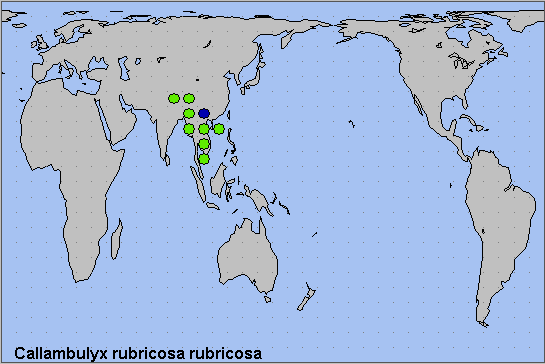
Holarctic; eastern Palaearctic region. Pleistocene refuge: Monocentric -- Yunnan refugium.
 Return to Sphingidae of the Eastern Palaearctic species list
Return to Sphingidae of the Eastern Palaearctic species list